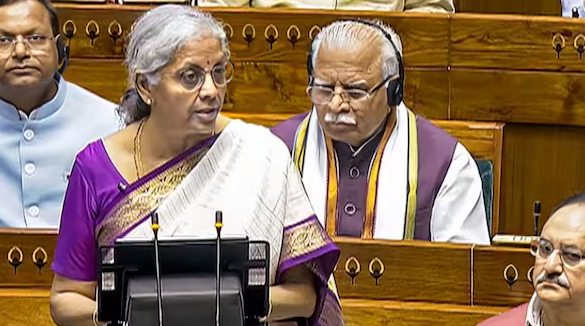Presenting Union Budget 2024, the first national budget in the third consecutive term of the Narendra Modi government, Union Finance Minister Nirmala Sitharaman announced comprehensive amendments to the Income Tax Act of 1961. This will reduce disputes and litigation. It is proposed to be completed in 6 months, she said.
An assessment of income tax can be opened beyond the existing time limit of three years if annual income is more than Rs 50 lakh (Rs 5 million), she said.
Advertisement
The finance minister announced the abolition of angel tax for all taxpayers.
Sitharaman also announced two major changes in the income tax rates and slabs for those adopting the new income tax regime. She announced standard deduction from Rs 50,000 to Rs 75,000 a year.
She also revised new tax regime slabs
- Up to Rs 3 lakh, no taxes.
- From Rs 3 lakh to Rs 7 lakh, 5 per cent
- From Rs 7 lakh to Rs 10 lakh, 10 per cent
- From Rs 10 lakh to Rs 12 lakh, 15 per cent
- From Rs 12 lakh to Rs 15 lakh, 20 per cent
- For annual income Rs 15 lakh and above, 30 per cent tax will be levied.
Salaried employee in new tax regime will save up to Rs 17,500 in income tax, Sitharaman said.
In 2020, Nirmala Sitharaman introduced a new personal income tax regime in addition to the existing personal income tax slabs. The new slabs were introduced as a simplified tax plan but those opting for the new income tax regime were not eligible for various tax exemptions under different IT Act sections.
Sitharaman introduced more changes introduced in the personal tax for individuals opting for the new personal tax regime in the Union Budget 2023. For example, the surcharge rate was brought down from 37 per cent to 25 per cent for individuals having taxable income more than Rs 5 crores. She also raised the basic exemption limit by Rs 50,000, giving 100 per cent tax rebate on income up to Rs 7 lakh.
Under the existing regimes of personal income tax, rates and slabs for the new income tax regime range from zero to 30 per cent. Those opting for the new tax regime, zero tax is levied on income up to Rs 3 lakh a year. A five per cent tax is imposed on the annual income of over Rs 3 lakh and up to Rs 6 lakh.
Those earning more than Rs 6 lakh a year have to pay a 10 per cent tax, applicable to income of up to Rs 9 lakh. Those earning between Rs 9 lakh and Rs 12 lakh have to pay tax at the rate of 15 per cent.
The next income slab is for those earning between Rs 12 lakh and Rs 15 lakh, and they are liable for a tax rate of 20 per cent. Those earning above Rs 15 lakh have to pay personal income tax at 30 per cent annual rate.
The existing rules set the eligibility limit for rebate at Rs 7 lakh. This means that the government would not collect tax from the earner if the tax liability is up to Rs 25,000.
The big picture is that the incremental income tax liability is higher than incremental income above Rs 7 lakh.
Under the old tax regime, annual income up to Rs 2.5 lakh is free from tax liability. A five per cent tax is levied in the next slab on income up to Rs 5 lakh. However, the government gives a rebate of Rs 12,500 on taxes — this means no tax is collected on income up to Rs 5 lakh.
A 20 per cent tax rate is applied to annual income between Rs 5 lakh and Rs 10 lakh. And the top slab of 30 per cent tax is imposed on annual income of over Rs 10 lakh.
The government levies a surcharge on the income tax if total income exceeds Rs 50 lakh. The rates of surcharge are 10 per cent for annual income between Rs 50 lakh and Rs 1 crore (Rs 10 million), 15 per cent on annual income between Rs 10 million and Rs 20 million, and 25 per cent on annual income between Rs 20 million and Rs 50 million.
These surcharge rates are the same for both old and new income tax regimes except for the annual income slab of over Rs 50 million. For this income category, a surcharge of 37 per cent is imposed on tax liability under the old tax regime and 25 per cent under the new tax regime.





